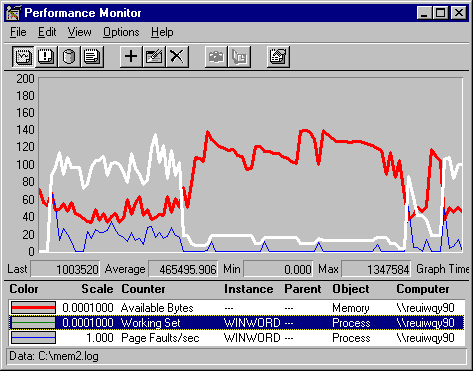
Available bytes is a measure of free memory. The Virtual Memory Manager continually adjusts the space used in physical memory and on disk to maintain a minimum number of available bytes for the operating system and processes. When available bytes are plentiful, the Virtual Memory Manager lets the working sets of processes grow, or keeps them stable by removing an old page for each new page added. When available bytes are few, the Virtual Memory Manager must trim the working sets of processes to maintain the minimum required.
The following graph records the start of a process. It shows the relationship between page faults, the size of the working set of a process, and available bytes. When a process is faulting many pages, the Virtual Memory Manager increases the process's working set to slow the fault rate. The memory added to the working set is taken from available bytes, which shrinks accordingly. When available bytes falls close to the minimum tolerated by the system, the Virtual Memory Manager trims the working sets to recover some available bytes. The smaller working set makes page faults more likely, requiring the Virtual Memory Manager adjustment cycle to begin again.

In this graph, which records the start of the Microsoft Word process, Winword.exe, the thick black line is Available Bytes, the white line is Working Set, and the thin black line is Page Faults/sec. The vertical maximum has been increased to 200 to accommodate the high values.
This example demonstrates the close association between the number of page faults and the increase in the working set. Note the inverse relationship between the size of the process's working set and available bytes for the system.
For the first third of the graph, the Virtual Memory Manager responds to page faults by dramatically increasing the size of the working set. Then, to recover available bytes, the working set is trimmed; thereafter, the Virtual Memory Manager responds to page faults by moving in just needed pages and by removing pages not recently referenced to keep the size of the working set to a minimum. At the end of the graph, an increase in the page fault rate drives the size of the working set back up.